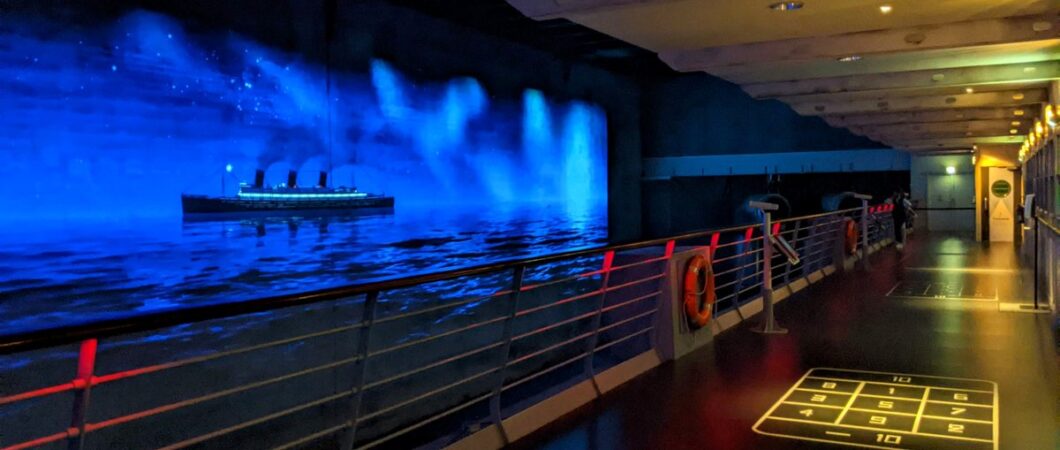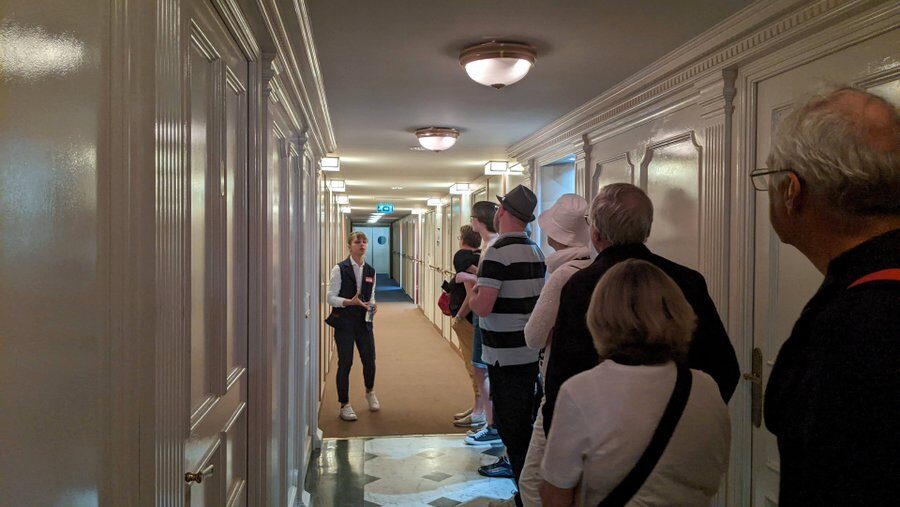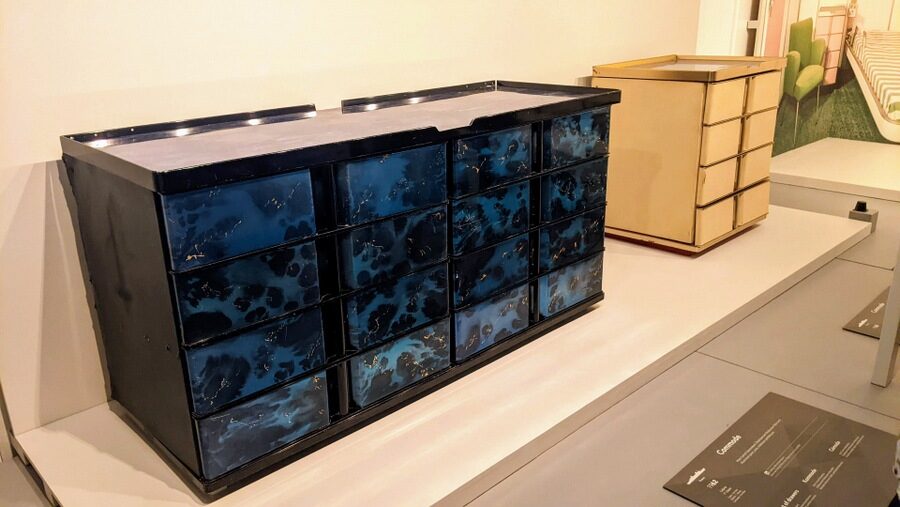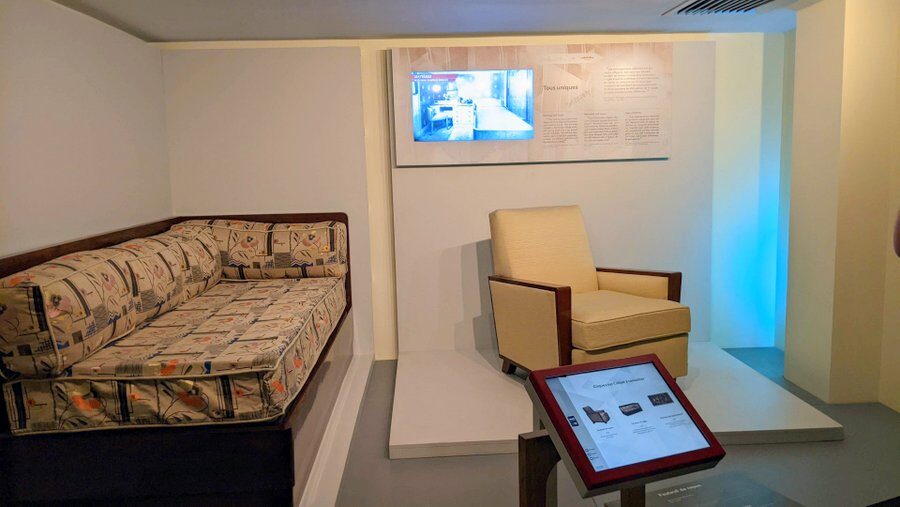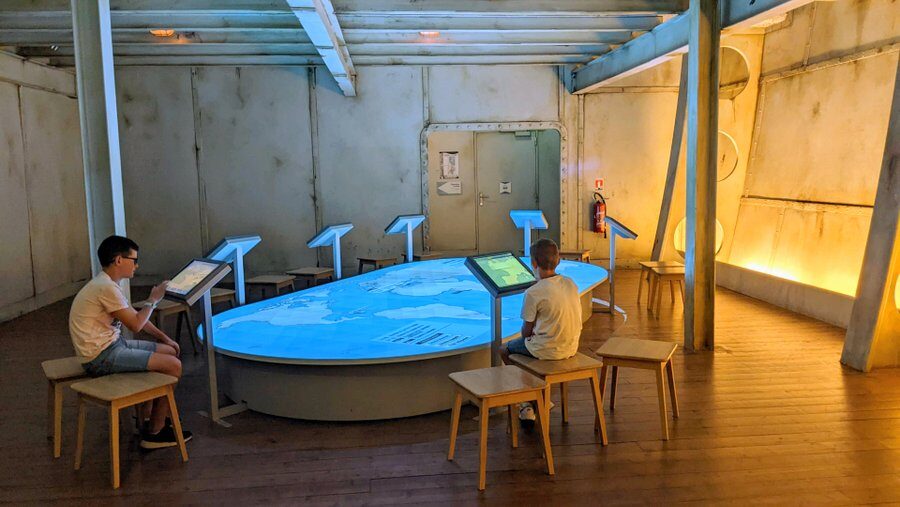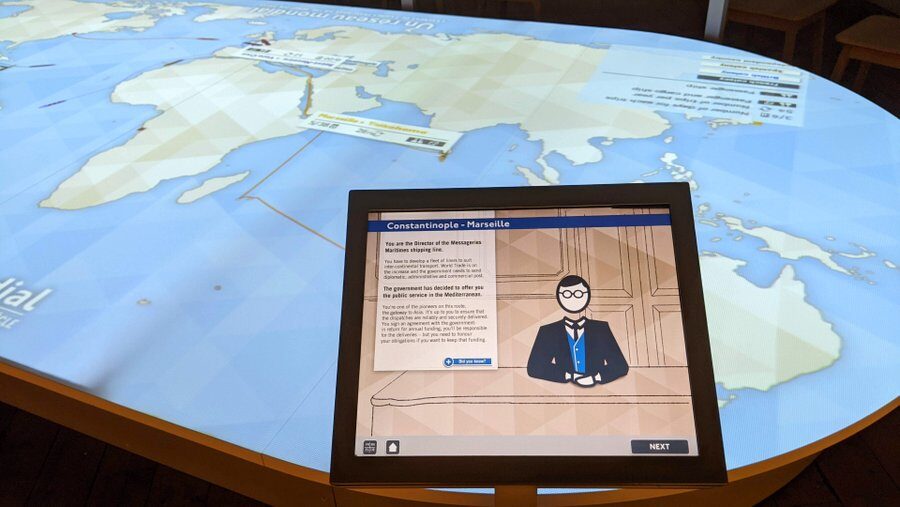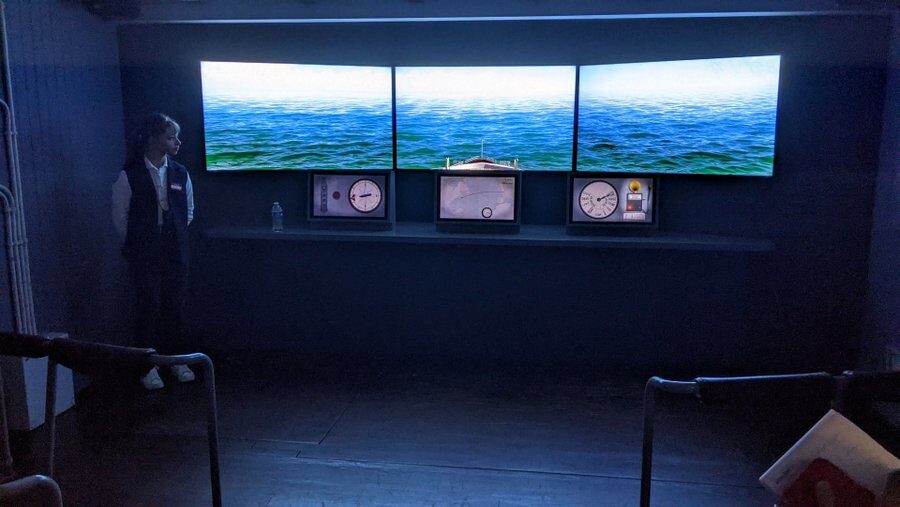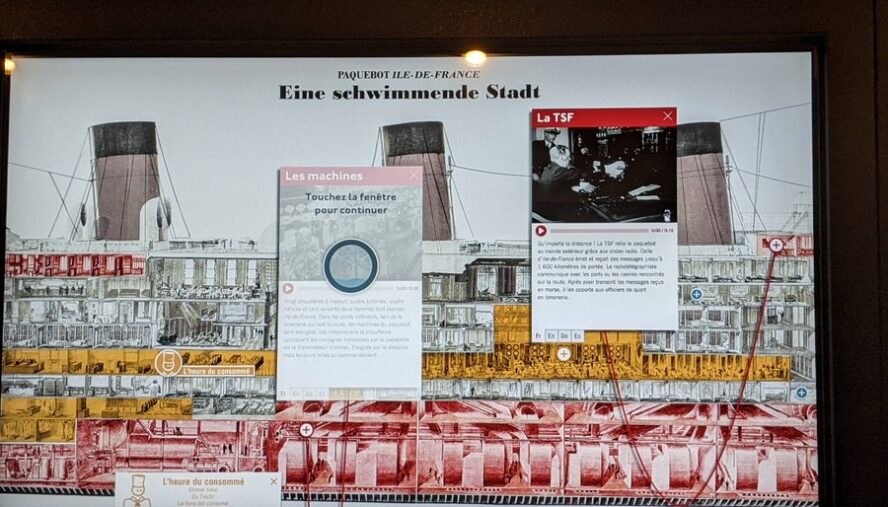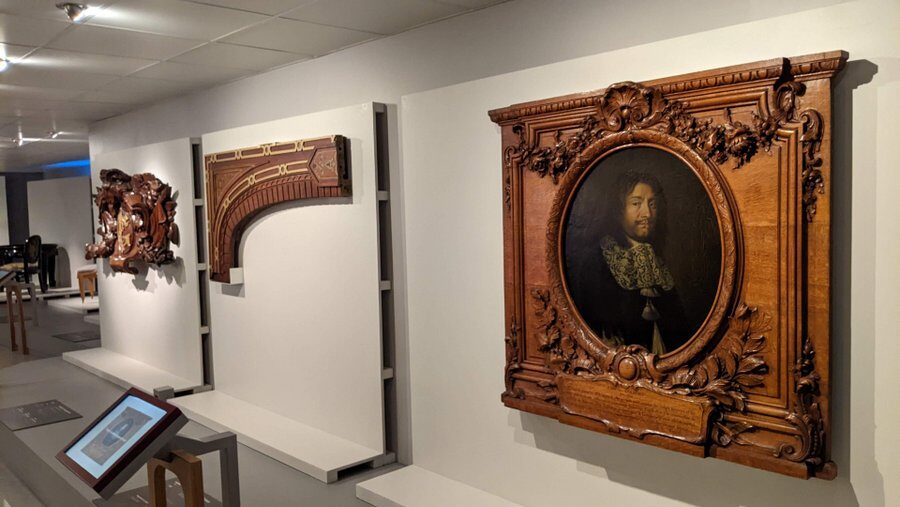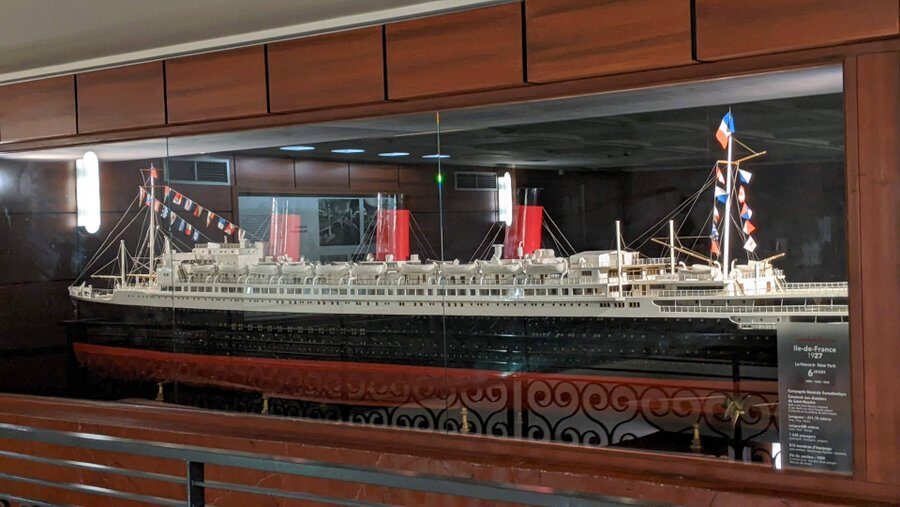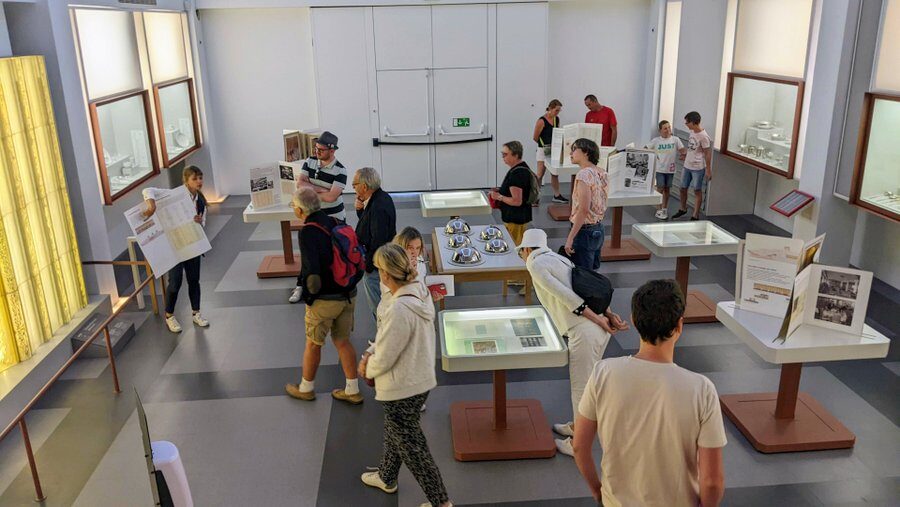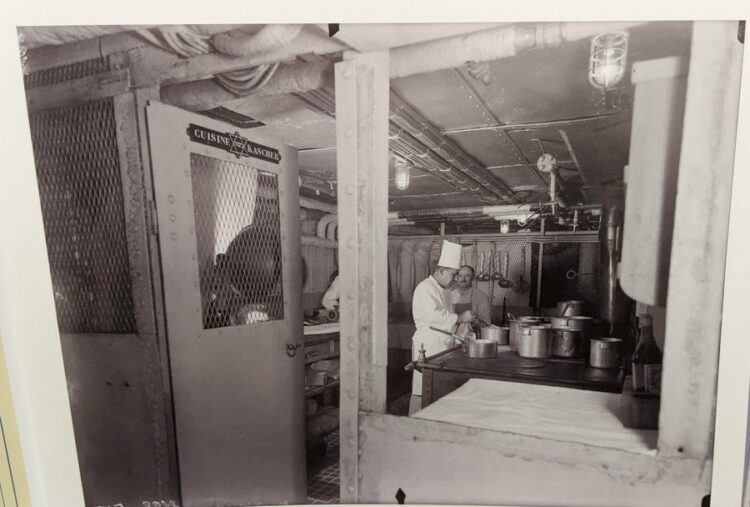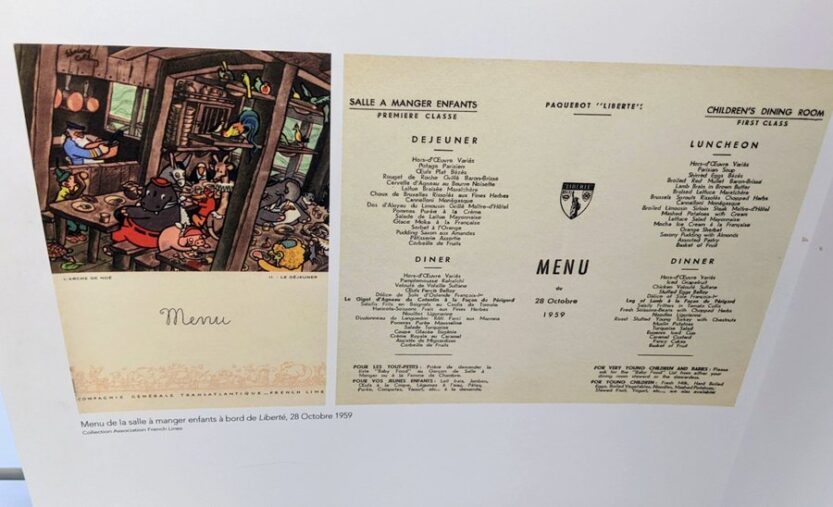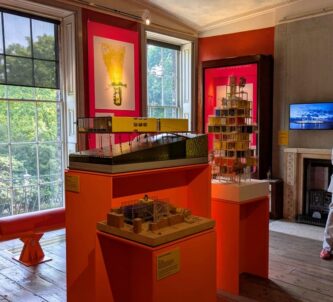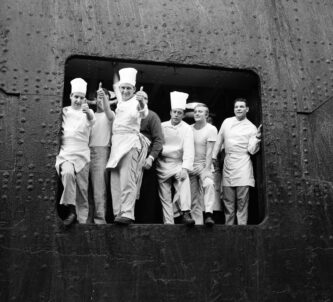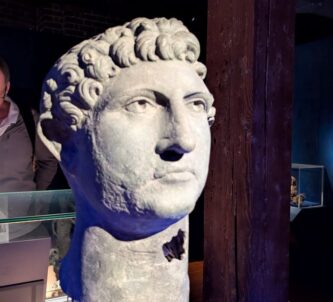Escal’Atlantic is a visitor experience, recalling the heyday of the great French liners or “paquebots” (mailships)* that carried mail and passengers across the Atlantic, and around the world, at speed and in style.
The experience recreates a classic passenger liner using sets and artefacts based on some of the great liners that emerged from the shipyards of Saint-Nazaire or sailed from the port, such as La Provence (1906), Ile-de-France (1927), Normandie (1935), Liberté (1950), and France (1962).
Other Saint-Nazaire Posts
Escal’Atlantic is rather ingeniously built inside one of the submarine pens in the former WW2 U-Boat base in Saint-Nazaire, which happens, by coincidence or design, to be on exactly the same quayside spot that many of the paquebots sailed from before the war. It has around twenty display areas featuring all the key parts of a transatlantic liner in the golden age of passenger ships, from the grand entrance foyer; First, Second and Third class accommodation; promenade decks; engine room; bridge and dining room.
You can either make a self-guided tour of the ‘ship’ armed with a printed guide in English, or join a guided tour in French. They will do bespoke guided tours in English for special groups or coach parties, but my reading of the situation is that there aren’t enough independent English-speaking visitors to add English language tours into the schedule.
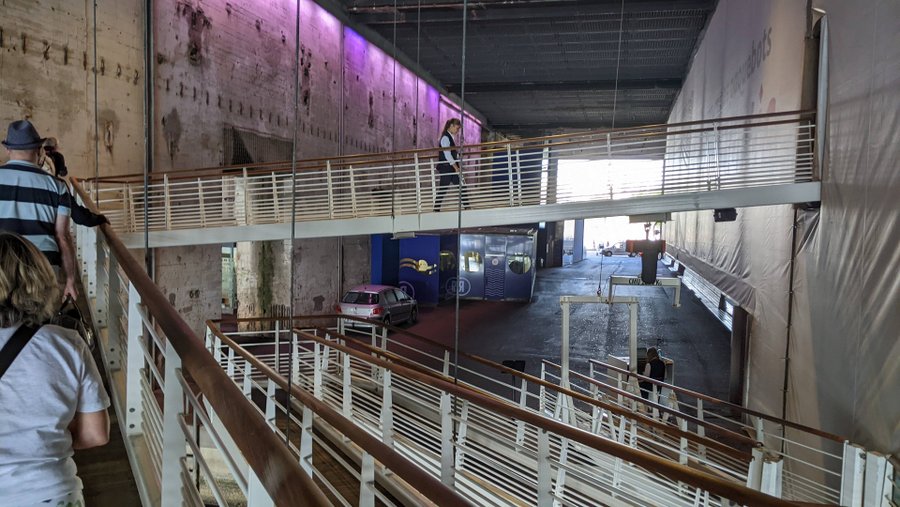
Whichever way you visit, you begin by boarding via a long gangway leading into the ship and the Grand Entrance Foyer dominated by a set of four lacquer panels called “The Hunt” made in 1935 by the famous French artist, Jean Dunand, for the walls of the first-class smoking lounge of the SS Normandie.
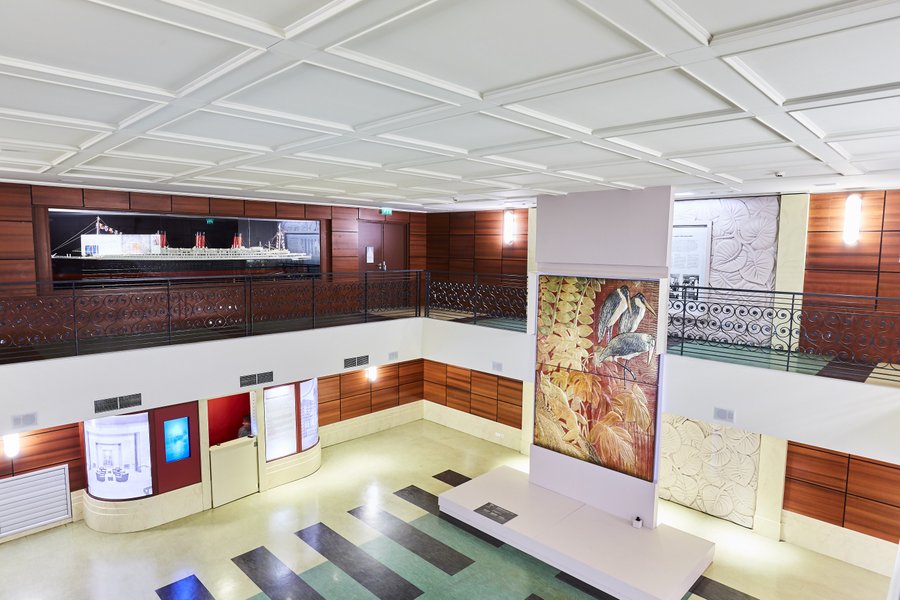
They are part of the museum’s collection of 200 items and artworks from the ships of the era, and they are extremely rare. Tiphaine Yvon, head of Saint-Nazaire’s heritage centre estimated the panels had up to 35 layers lacquer and gold which the artist spent 2 years applying, sculpting, chiselling and sanding. In 1942, while berthed in New York, SS Normandie was requisitioned to be a troopship. The panels and other artworks were removed before the conversion began, which was just as well because during the conversion an accidental fire broke out and she sank at her berth.
The tour path takes you along corridors and past examples of First & Second class cabins with their furniture and decorations. The specially commissioned furniture in First Class could be both elegant and practical, such as the blue lacquered multi-drawer sideboard on board SS France (1962) and the smaller brown one on board SS Liberte (1950) – note both have ‘fiddles’, raised surrounds to stop items rolling off in a heavy sea.
Likewise the art deco style furniture in the First Class cabins of SS Normandie (1935) with a metal strap under the armchair, bolting it to the floor so it can’t slide around in bad weather.
Second Class, in this case on board the Liberte (1950), was less glamorous and more crowded.
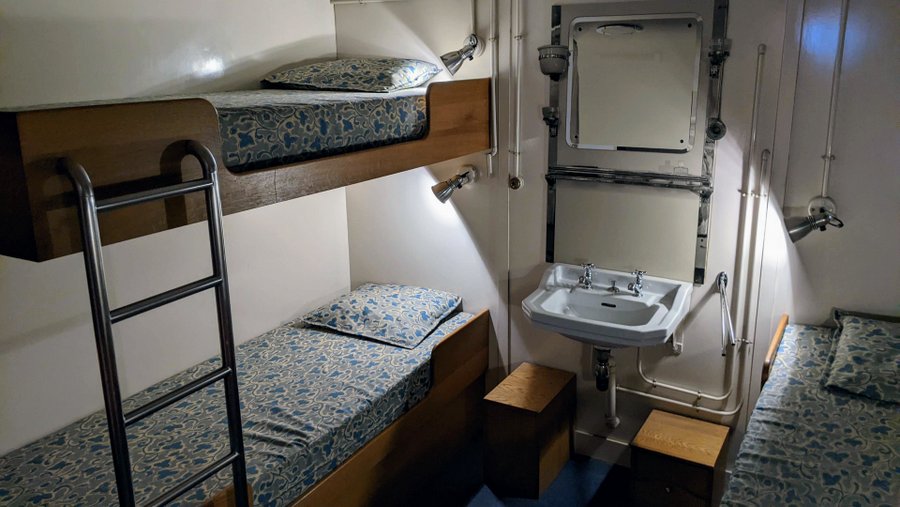
But nothing like ‘steerage’ down below where the Third Class passengers lived. Here the European immigrants heading for a new life in the New World, were packed into open dormitories.
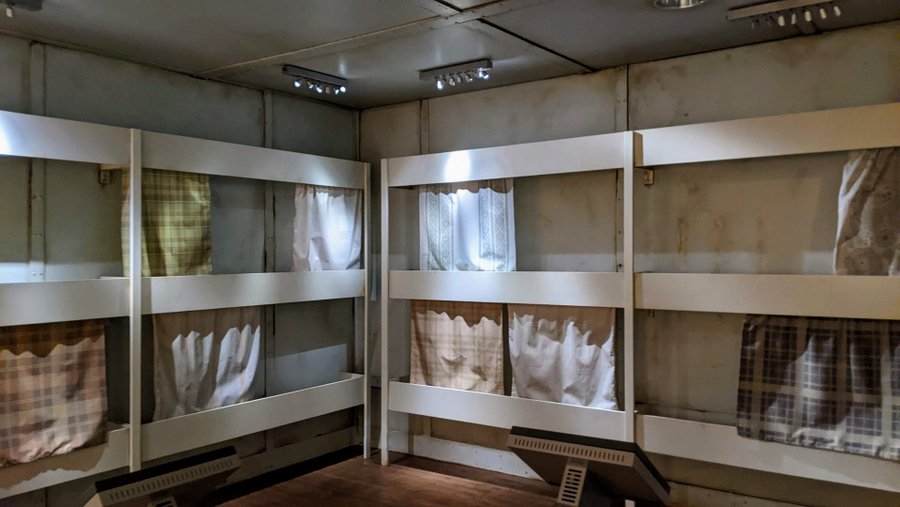
One thing that seems rather counter-intuitive these days, is the distribution of passengers. The SS Normandie was considered the most prestigious ocean liner of her day, and so naturally all the ‘best’ people – aristocracy, politicians, tycoons, celebrities – wanted to travel on her. The results was that she carried more First Class passengers (848) than Second Class (665) or ‘the masses’ in Third Class (458). In fact the ‘toffs’ outnumbered the ‘peasants’ almost 2:1!
In this section of the ship – down in the hold – there’s an interesting digital simulation. You can play the role of a ship-owner around 1900 who has signed a contract to run mailships on a selection of routes. I took on the Messageries Maritimes Company, operating my first ship on the Constantinople to Marseilles route.
I almost came unstuck straight away when my first mate fell ill on the eve of departure and I had to decide what to do – delay departure or find a replacement. I managed to find a qualified 1st mate and set sail. More decisions had to be made on route, such as burn more expensive fuel to keep to schedule in bad weather, but eventually I arrived in Marseilles where I nearly had the contract taken away from me because my replacement 1st Mate was English and only Frenchmen could be used on a French mailship… a bit harsh I thought!
From here the tour route passes through the ship’s stores (all that food & wine) and the engine room, before climbing back up and out onto the promenade decks.
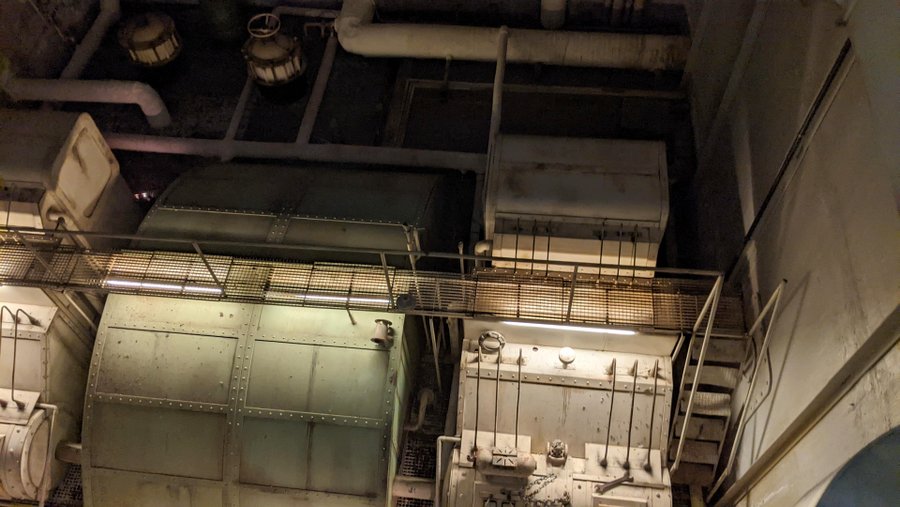
I think the promenade areas are the best parts of the ‘ship’. They’ve made good use of the huge submarine pen to recreate the views over water, from the stern rail, the enclosed promenade deck, and the open promenade deck. And there are things to look at – wildlife, passing ships, passing icebergs – all the time.
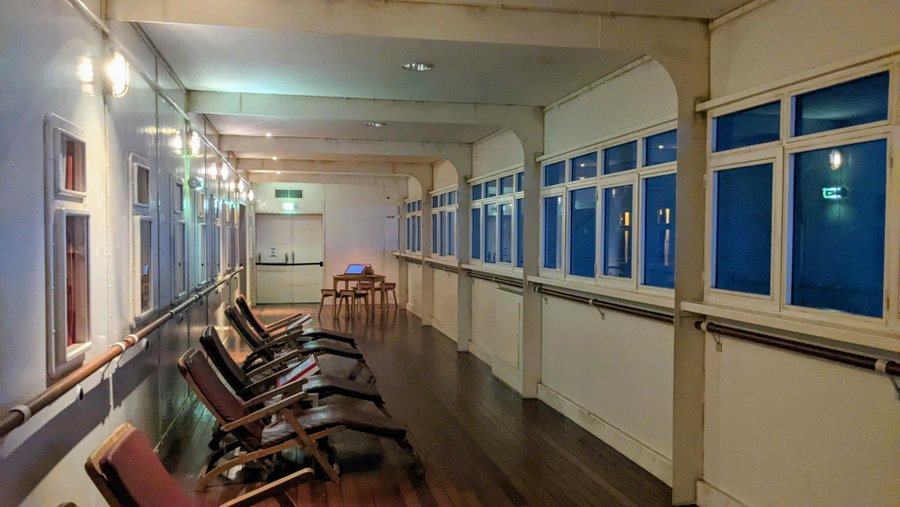
The open promenade deck is my favourite. For one thing a large fan drives a brisk breeze along the deck, and there are digital telescopes which you can use to view the passing objects.
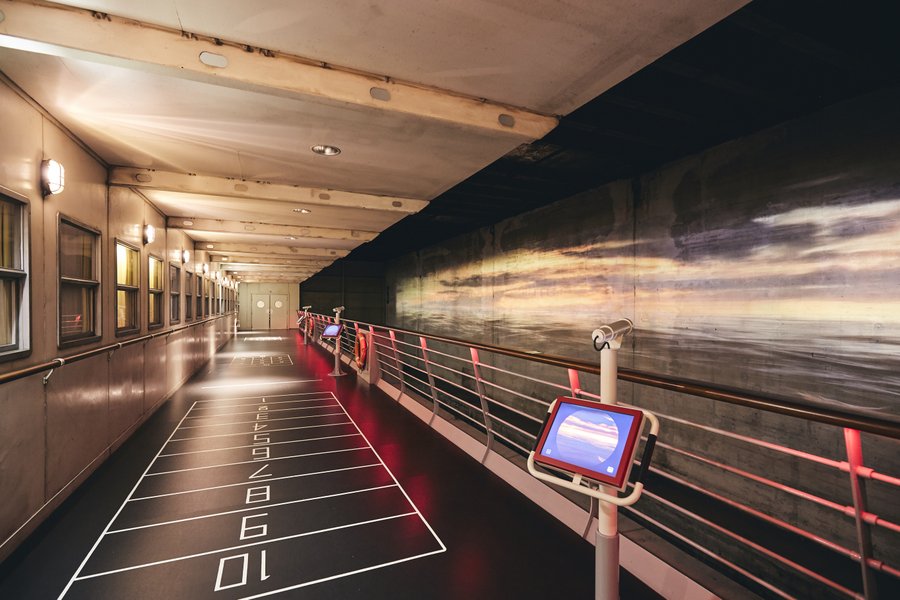
Up on the bridge there is theatre style seating so visitors can take the weight off their feet while the guide explains the intricacies of navigation. Then there’s a sort of mini museum with interactive digital displays explaining the inner workings of the SS Ile-de-France (1927). You can press on any part of the ship to find out more about it and the people who worked there. The museum also has some more rare pieces of furniture and decorations saved from the famous ships.
The museum is on the balcony level of the Grand Entrance Foyer (with a rather impressive model of the Ile-de-France) and the tour route brings you out over the bar, looking down at the ‘Dining Room’.
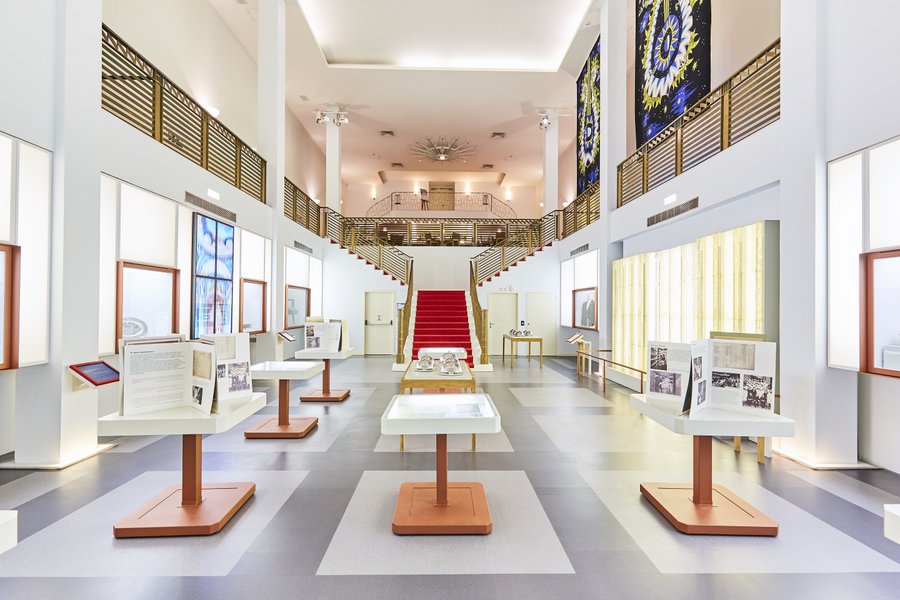
There’s a photo of the famous 1st class dining room on the SS Normandie. It was huge; the world’s largest room afloat. At 93 metres long it was longer than the Hall of Mirrors at the Palace of Versailles… and exactly the same width (14m) and only 2 metres shorter than the submarine pen in which Escal’Atlantic sits!
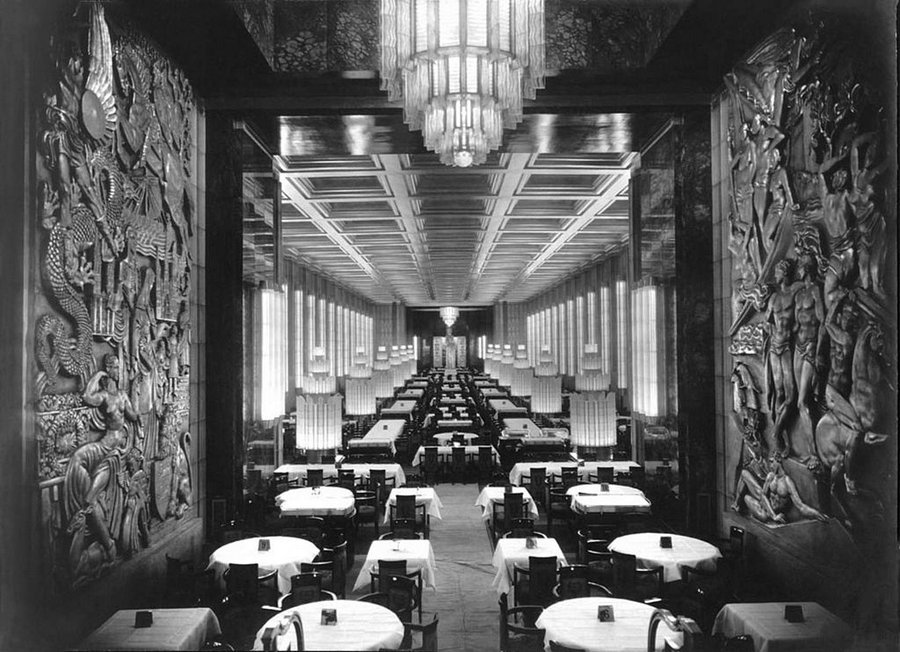
This ‘Dining Room’ has displays of elegant crockery and cutlery used on some of the ships, and the mouth-watering menus. Some menus were quite specialist. There was a big demand for kosher meals (all prepared in a dedicated kitchen), and kids’ menus – in the case of the 1st class children, served in a dedicated room. The walls of children’s dining room on the SS Normandie were decorated with images of the cartoon elephant, Babar, painted by the artist herself.
The last stop on the tour is a cinema which shows films about the ‘paquebot’ era (in French only) before visitors are invited to leave the ‘ship’ by lifeboat…
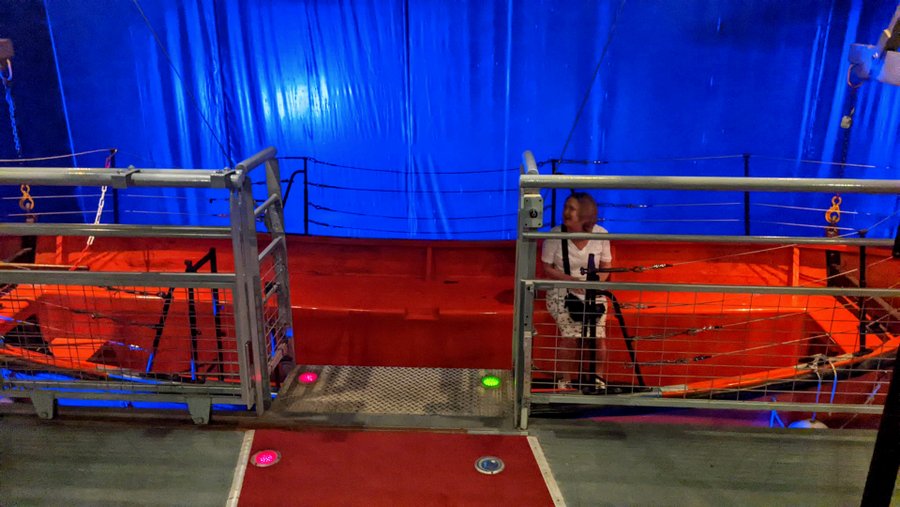
…where, once back at ground level, there is naturally, a museum shop.
Declaration: I was on a self-driving press trip as a guest of the Saint-Nazaire tourist office.. Escal’Atlantic entry was complementary.
Factbox
The Name:
“Escal’Atlantic” is colloquial French. It means ‘Atlantic stopover’ or ‘Atlantic port of call’.
Website:
Saint-Nazaire Tourisme – Escal’Atlantic
(Saint-Nazaire Tourisme operates all the key sites and tours in the Saint-Nazaire commune, so their website covers each site and handles ticketing.)
Getting there:
Escal’Atlantic,
Submarine base,
Boulevard de la Légion d’Honneur,
Saint-Nazaire,
France.
Escal’Atlantic is located in the next dock to the Tourist Office in the submarine base.
Entry Price (2023):
| Adult | Reduced* | Child (4-17) | |
|---|---|---|---|
| Escal’Atlantic | € 15.00 | € 13.00 | € 7.50 |
| Combined Ticket (Escal’Atlantic + Espadon submarine + Écomusée + EOL Centre Éolien) | € 28.00 | € 14.00 | |
| ‘Transat Pass’ (Escal’Atlantic + Écomusée) | € 16.00 | € 8.00 | |
| ‘Boarding Pass’ (Escal’Atlantic + 1 factory tour: Airbus or Chantiers de l’Atlantique) | € 26.00 | € 13.00 |
* Reduced tickets are for students, job seekers, people with disabilities with one accompanying person
Children under the age of 4 and Annual PASS holders have free entry. Admission is also free on the first Sunday of the month, except July and August.
Opening Days:
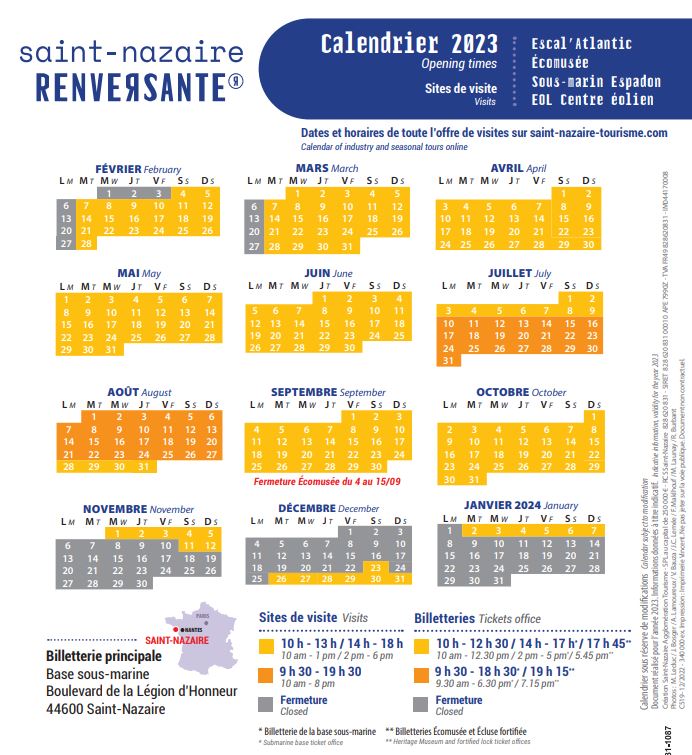 The four Saint-Nazaire Tourisme attractions (EOL Centre éolien, Submarine Espadon, Écomusée & Escal’Atlantic) share the same calendar. They are open on most days during the summer but as you get into the winter the dates become more specific and you need to check if the actual date you want to visit is available on the website.
The four Saint-Nazaire Tourisme attractions (EOL Centre éolien, Submarine Espadon, Écomusée & Escal’Atlantic) share the same calendar. They are open on most days during the summer but as you get into the winter the dates become more specific and you need to check if the actual date you want to visit is available on the website.
Opening Hours:
Tickets for the four attractions are timed. Tickets for the Escal’Atlantic are based on a 60 – 90 minute visit and sold in 10 minute time slots.

